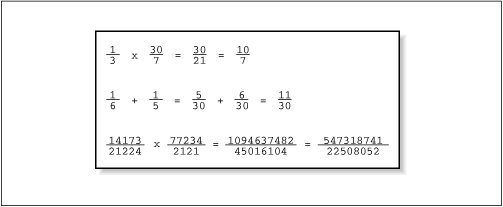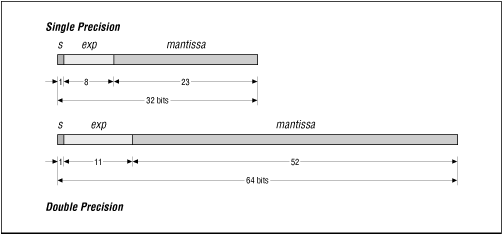Reality and Representation
(0.1)10 = (0.000110...)2 (see below)
What about the ruler? The one I have brought to class today can measure up to a magnitude of 12 inches with a precision of 1/16 inch. What do you do if the item you are measuring does not fall exactly on one of the pre-printed marks?

© O'Reilly Publishers (Used with permission)
Symbolic mathematical packages, such as maple and mathematica provide the capability to exactly represent values such as these - at the cost of storing each digit in the numerator and the denominator and performing any needed arithmetic by using the greatest common divisor (GCD) to reduce fractions to their simplest form. Even with the growing speed of CPUs, the cost can be prohibitive when millions of arithmetic operations need to be performed in scientific simulations.
Fixed Point
Mantissa/Exponent
- mantissa,
- base and
- exponent,
- Biologists who study population dynamics need to be able to represent, for example, 270 Million people, but a half person does not make sense. Other biologists may study organisms on the microscopic scale in their molecular studies.
- Astronomers measure distances between galaxies which are very large magnitude values.
- Other disciplines and their scales that the class is familiar with?
Fig. 4-2 Distance between successive floating-point numbers

© O'Reilly Publishers
(Used with permission)
You can have multiple presentations of the same value:
6.00 * 10^5 = 0.60 * 10^6 = 0.06 * 10^7 = 600,000 = six hundred thousand
therefore, by convention, shift the mantissa (and adjust the exponent)
until there is exactly one nonzero digits to the left of the decimal
point (called normalized), therefore use 6.0*10^5 or 6.0E5 since
the base of 10 can be assumed..
Fig. 4-3 Normalized floating-point numbers

© O'Reilly Publishers
(Used with permission)
There is a loss of precision. 1/2 and 0.25 can be represented exactly as binary fractions. Can you give them?
But 1/10 = 0.1 cannot be represented exactly as a binary fraction. Wednesday's Lab (1Oct03), we will briefly examine Exercise 1 (p. 77) from this chapter to see that adding 1/10 to itself 10 times does not yield 1.
NOTE:
- 0.510 = 0.12,
- 0.2510 = 0.012,
- 0.110 = 0.00011001...2
More Algebra that Doesn't work
X = 1.25E8 Y = X + 7.5E-3 IF (X .EQ. Y) THEN PRINT*, "Am I nuts or what?" ENDIF
Fig. 4-4 Loss of accuracy while aligning decimal points

© O'Reilly Publishers
(Used with permission)
The .0075 part in the result will be dropped off (truncated or
rounded) when this value is stored to memory.
Another facet is that mathematical properties, such as addition is commutative and associative will not hold true.
(X + Y) + Z = (Y + X) + Z - commutative is okay (X + Y) + Z = X + (Y + Z) - associative does NOT holdAnd our text provides the following example. Assume our computer can perform arithmetic with only five significant digits and let X = .00005, Y = .00005, and Z = 1.0000
(X + Y) + Z = .00005 + .00005 + 1.0000
= .00010 + 1.0000 = 1.0001
X + (Y + Z) = .00005 + .00005 + 1.0000
= .00005 + 1.0000 = 1.0000
Whenever possible, add the small numbers together first.
Improving Accuracy Using Guard Digits
Fig. 4-5 Need for guard digits (example of a subtraction)

© O'Reilly Publishers
Formatting (by programmer source code)
-
C Language Format Conversion specification strings
- Fortran Formats
- What happens if the programmer specifies a format and the computed
value is represented as 0.0?
- What if a value is computed that is too large to fit in the computer word?
- Overflow
- What if a value is computed that is too small to fit in the computer word?
- Underflow
- Harmonic Series converges in computer arithmetic
-
A famous example from your calculus course is the harmonic series,
SUMi=1inf 1/i
1 + 1/2 + 1/3 + 1/4 + 1/5 + 1/6 + = ?
which mathematics tells us will not converge to a value. But what happens if you sum this series on a computer using floating-point numbers? Think about, what if you summed it backwards? Pick a value of N and add up
1 + 1/2 + 1/3 + ... + 1/N
You can make a table of N and Harmonic Series(N)
IEEE Floating-Point Standard
During the 1980's, the Institute for Electrical and Elecronics Engineers (IEEE) produced a standard for the float-point format, strongly led by W.B. Kahan, UC Berkeley, the IEEE 754 floating-point format. An Interview with the Old Man of Floating-Point Reminiscences elicited from William Kahan by Charles Severance. The efforts by many to produce a standard that has been adopted by nearly all computer manufacturers today has greatly simplified the life of the HPC programmer.In the diagram below, the field exp determines the magnitude (size) of the numbers that can be presentated. The field mantissa determines the precision (accuracy) that the number has. The one-bit field s determines the sign of the number (+ or -).
Fig. 4-6 IEEE 754 floating-point formats

© O'Reilly Publishers
Used with permission)
- Storage format
- Precise specifications of the results of operations
- Special values
- Specified runtime behavior on illegal operations